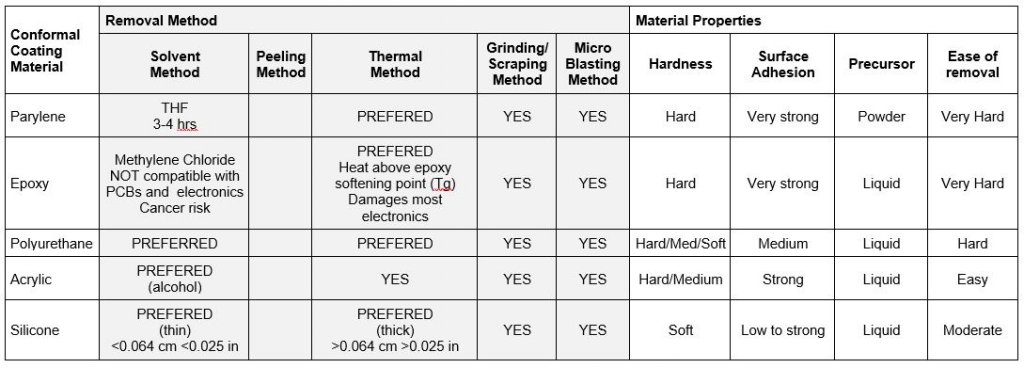<< View SCS Blog
Removing Conformal Coatings
Conformal coatings provide a long-term, stable and reliable encapsulation method for the electronic components from environmental effects. Different industries and service conditions call for different protective coatings. In some cases, changes in the requirements or mistakes would call for action to remove the coating. While some coating materials are easily removed, some are virtually impossible to remove without damaging the products (eg. epoxy coatings).
IPC-7711C/7721C, titled Rework, Modification and Repair of Electronic Assemblies [1], has standardized the coating removal process. According to the IPC-7711C/7721C, coating removal starts by the identification of conformal coating type (Fig. 1) and followed by the selection of the method to be used depending on the substrate and components. If prepared onsite, the coating material is generally known. If the coating was done elsewhere, the following chart can be used to identify the type of conformal coating.

The removal method is selected in a way that the least or no damage is imparted to the substrate (be it PCB or silicon wafer etc.) and its components. Possible removal methods listed in the standard are below (Fig. 2). Oxygen plasma and laser ablation, while not identified in the standard, are also methods that are highly preferred for conformal coating removal from microelectronics.

Solvent Method: Removal of the conformal coating using a solvent is very attractive due to the bench-top type of process. Most conformal coatings are chemically very resistant and are very hard to remove by solvents. For small areas, the solvent is applied using a using a foam swab. For larger areas, the product can be immersed if the chemicals are not damaging to the underlying electronic parts.
Peeling Method: Mechanically peeling off of the coating. This method might require pre-processing, such as thermal or chemical processes. The peeling off can be done if the surface adhesion between the conformal coating and the bond surface is not strong. However, conformal coatings usually have very strong bonding interfaces with the substrates. While the method sounds attractive it is mostly not applicable.
Thermal Method: Thermal removal is performed using controlled heating. The sample is heated up in a controlled way and the coating can be tested for removal in a tiny spot. The test temperature is elevated from room temperature to approximately at 100°C and can be increased gradually if needed. The coating changes and component thermal limitations must be watched to protect the overall health of the electronics.
Grinding/Scraping: While this method sounds relatively easy, it can be very invasive and extra attention is required. Friction between the abrasive and the surface or components may lead to device failure.
Micro Blasting Method: Abrasion operations can generate electrostatic charges, but most chambers are grounded, dissipating the static charges. Micro abrasive blasting propels specific formulas of inert gas/dry air and abrasive media at the coated component, via a tiny nozzle attached to a stylus; either a handheld manual or automated system can be used to pinpoint the targeted removal area.
IPC-7711C/7721C also offers suggestions for removal methods for the different conformal coating materials, and the materials’ properties (Table 1).

Acrylic is very easy to rework and is readily dissolved in common solvents such as xylene. If the coating must be removed or reworked after the application, acrylic is the best choice for the application.
Parylene, epoxy, polyurethane and silicone are chemically inert and their chemical removal is not very easy or may require chemicals that can also damage the PCB and underlying substrate. Chemical removal of epoxy and polyurethane is done by harsh chemicals which may present risks to employees. Mostly thermal coating removal is advised for epoxy. Thermal coating removal technique is not always advisable as it can leave stains, discoloration and damage the electronic components.
Parylene is a pinhole-free, uniform conformal coating that can coat the smallest crevices of the electronic products and it can be hardly removed by chemicals. Tetrahydrofuran (THF),a very harsh chemical, can aid in the delamination of the Parylene layer which can later be removed by tweezers. Approximately 3 hours of immersion is needed for delamination. Benzolyl benzoate and chloronapthelene above 150°C are also known to remove Parylene. However, these chemicals can damage the PCB and electronic components and therefore are not advised. Chemical removal of Parylene is not a recommended process.
Laser ablation, reactive ion etching (oxygen plasma), and micro-abrasion are the best options for the removal of Parylene. These methods can be applied precisely for microelectronic structures on silicon wafers as well. Also, micro abrasion blasting using abrasives and compressed air can remove conformal coatings such as Parylene and epoxy.
Mechanical manipulation of the coatings must be applied carefully since they can cause unexpected failures due to mechanical impact on the structures.
References
[1] “IPC-7711C-7721C table of contents,” p. 17, 2017.

